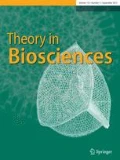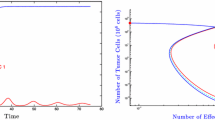Abstract
A mathematical model for the quantitative analysis of cancer–immune interaction, considering the role of antibodies has been proposed in this paper. The model is based on the clinical evidence, which states that antibodies can directly kill cancerous cells (Ivano et al. in J Clin Investig 119(8):2143–2159, 2009). The existence of transcritical bifurcation, which has been proved using Sotomayor theorem, provides strong biological implications. Through numerical simulations, it has been illustrated that under certain therapy (like monoclonal antibody therapy), which is capable of altering the parameters of the system, cancer-free state can be obtained.





Similar content being viewed by others
References
Adam J, Bellomo N (1997) A survey of models for tumor immune dynamics. Birkhauser, Boston, MA
Adams GP, Weiner LM (2005) Monoclonal antibodies therapy of cancer. Nat Biotechnol 23(9):1147–1157
Banerjee S, Sarkar RR (2008) Delay Induced-model for tumor–immune interaction and control of malignant tumor growth. Bio Syst 91:268–288
Banerjee S, Khajanchi S, Chowdhuri S (2015) Mathematical model to elucidate brain tumor abrogation by immunotherapy with T11 target structure. PLoS ONE 10(5):1–21
Banerjee S, Tsygvintsev A (2015) Stability and bifurcations of equilibria in a delayed Kirschner–Panetta model. Appl Math Lett 40:65–71
Bodnar M, Foryś U (2000) Periodic dynamics in the model of immune system. Int J Appl Math Comput Sci 10(1):1201–1209
Chaplain MAJ, Matzavinos A (2006) Mathematical modeling of spatio-temporal phenomena in tumor immunology. Springer, Berlin
de Pillis LG, Gu W, Radunskaya AE (2006) Mixed immunotherapy and chemotherapy of tumors: modeling, applications and biological interpretation. J Theor Biol 238:841–862
Foryś U (2002) Marchuk’s Model of Immune System Dynamics with Application to Tumor Growth. J Theor Med 4(1):85–93
Fink M (2006) myAD: fast automatic differentiation code in Matlab. http://www.mathworks.com/matlabcentral/fileexchange/loadFile.do?objectId=15235. Accessed 28 Oct 2016
Fink M, Batzel JJ, Tran H (2008) A respiratory system model: parameter estimation and sensitivity analysis. Cardiovasc Eng 8:120–134
Gabriel JA (2007) The biology of cancer, 2nd edn. Wiley, Boca Raton
Ivanov A, Beers SA, Walshe CA, Honeychurch J, Alduaij W, Cox KL, Potter KN, Murray S, Chan CHT, Klymenko T, Erenpreisa J, Martin GJ, Illidge Tim M, Cragg MS (2009) Monoclonal antibodies directed to CD20 and HLA-DR can elicit homotypic adhesion followed by lysosome-mediated cell death in human lymphoma and leukemia cells. J Clin Investig 119(8):2143–2159
Khajanchi S, Banerjee S (2014) Stability and bifurcation analysis of delay induced tumor immune interaction model. Appl Math Comput 248:652–671
Kirschner D, Panetta JC (1998) Modeling the immunotherapy of tumor–immune interaction. J Math Biol 37(3):235–252
Kirschner D, Tsygvintsev A (2009) On global dynamics of a model for tumor immunotherapy. Math Biosci Eng 6(3):579–583
Kolev M (2003a) Mathematical modeling of the competition between acquired immunity and cancer. Appl Math Comput Sci 13(3):289–296
Kolev M (2003b) Mathematical modeling of the competition between tumors and the immune systems considering the role of antibodies. J Math Comput Model 37:1143–1152
Kuznetsov VA, Makalkin IA, Taylor MA, Perelson AS (1994) Non-linear Dynamics of immunogenic tumors: parameter estimation and global bifurcation analysis. Bull Math Biol 56(2):295–321
Mallet DG, de Pillis LG (2006) A cellular automata model of tumor–immune system interactions. J Theor Biol 239:334–350
Nagumo N (1942) Uber die Lage der Integralkurven gewonlicher Differantialgleichungen. Proc Phys Math Soc Jpn 24:551–567
Nossal GJV, Makela O (1962) Elaboration of antibodies by single cell. Ann Rev Microbiol 16:53–74
Perelson AS, Mimirani M, Oster GF (1976) Optimal strategies in immunology, B-cell differentiation and proliferation. J Math Biol 3:325–367
Perko L (1991) Differential equations and dynamical systems, 2nd edn. Springer, New York
Preziosi L (1996) From population dynamics to modeling the competition between tumor and immune system. Math Model 23(6):135–152
Rosenberg S, Yang J, Restifo N (2004) Cancer immunotherapy: moving beyond current vaccines. Nat Med 10:909915
Sarkar RR, Banerjee S (2005) Cancer self remission and tumor stability—a stochastic approach. J Math Biosci 196:65–81
Schulz WA (2007) Molecular biology of human cancer. Springer, Berlin
Szymanska Z (2003) Analysis of immunotherapy models in the context of cancer dynamics. Int J Appl Math Comput Sci 13(3):407–418
Tsygvintsev A, Banerjee S (2014) Bounded immune response in immunotherapy described by delay Kirschner–Panetta model. Appl Math Lett 35:90–94
Acknowledgements
We are grateful to the anonymous reviewers for their comments and useful suggestions to improve the quality of the paper. This study was supported by the Indo-French Centre for Applied Mathematics (IFCAM) (Grant No. MA/IFCAM/13/120) and the Ministry of Human Resource Development (MHRD) (Grant No. MHR02-41-113-429).
Author information
Authors and Affiliations
Corresponding author
Appendix: Sotomayor theorem (Perko 1991)
Appendix: Sotomayor theorem (Perko 1991)
Consider the system of ordinary differential equations
where \(\eta \in {\mathbb {R}}\) is a system parameter. It is assumed that the function f is sufficiently differentiable so that all the derivatives appearing in that theorem are continuous on \({\mathbb {R}}^n\times {\mathbb {R}}\). We denote the matrix of partial derivatives of the components of the vector field f with respect to the components of x by Df and the vector of partial derivatives of the components of f with respect to parameter \(\eta\) denoted by \(f_{\eta }\).
Theorem 5
(Perko 1991) (Sotomayor):Suppose that \(f(x_0,\eta _0)\) and that \(n\times n\) matrix \(B\equiv Df(x_0,\eta _0)\) has a simple eigenvalue \(\lambda =0\) with eigen vector v and that \(B^T\) has an eigen vector u corresponding to the eigenvalue \(\lambda =0.\) Furthermore, suppose that B has k eigenvalues with negative real parts and \((n-k-1)\) eigenvalues with positive real parts.
-
(i)
If the following conditions are satisfied
$$\begin{aligned} u^Tf_\eta (x_0,\eta _0)\ne 0,~~~~~~~~u^T[D^2f(x_0,\eta _0)(v,v)]\ne 0 \end{aligned}$$(11)Then there is a smooth curve of equilibrium point of (10) in \({\mathbb {R}}^n\times {\mathbb {R}}\) passing through \((x_0,\eta _0)\) and tangent to the hyperplane \({\mathbb {R}}^n\times {\eta _0}\). Depending on the signs of the expressions in (11), there are no equilibrium points of (10) near \(x_0\) when \(\eta <\eta _0\) (or \(\eta >\eta _0\)) and there are two equilibrium points of (10) near \(x_0\) when \(\eta >\eta _0\) (or \(\eta <\eta _0\)). The two equilibrium points of (10) near \(x_0\) are hyperbolic and have stable manifolds of dimension k and \(k+1\) , respectively, that is, the system (10) experiences a saddle-node bifurcation at the equilibrium point \(x_0\) as the parameter \(\eta\) passes through the bifurcation value \(\eta =\eta _0\). The set of \(C^\infty\) -vector fields satisfying the above conditions is an open, dense subset in the Banach space of all \(C^\infty\), one parameter vector fields with an equilibrium point at \(x_0\) having a simple zero eigenvalue. (ii)If the following conditions are satisfied
$$\begin{array}{r} u^Tf_\eta (x_0,\eta _0)= 0,\nonumber \\ u^T[Df(x_0,\eta _0)v\ne 0 \nonumber \\ u^T[D^2f(x_0,\eta _0)(v,v)]\ne 0 \end{array}$$(12)the system (10) experiences a transcritical bifurcation at the equilibrium point \((x_0,\eta _0)\) as the parameter \(\eta\) varies through the bifurcation value \(\eta =\eta _0\).
Rights and permissions
About this article
Cite this article
Ghosh, S., Banerjee, S. Mathematical modeling of cancer–immune system, considering the role of antibodies. Theory Biosci. 137, 67–78 (2018). https://doi.org/10.1007/s12064-018-0261-x
Received:
Accepted:
Published:
Issue Date:
DOI: https://doi.org/10.1007/s12064-018-0261-x




